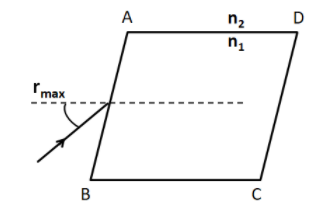
A rectangular glass slab ABCD of refractive index \[{n_1}\] is immersed in water of refractive index ${n_2}$ $\left( {{n_1} > {n_2}} \right)$. A ray of light is incident to the surface AB of the slab as shown. The maximum value of the angle of incidence ${r_{\max }}$ such that the ray comes out only from the another surface CD is given by

(A) ${\sin ^{ - 1}}\left[ {\dfrac{{{n_1}}}{{{n_2}}}\cos \left( {{{\sin }^{ - 1}}\left( {\dfrac{{{n_1}}}{{{n_2}}}} \right)} \right)} \right]$
(B) ${\sin ^{ - 1}}\left[ {{n_1}\cos \left( {{{\sin }^{ - 1}}\left( {\dfrac{1}{2}} \right)} \right)} \right]$
(C) \[{\sin ^{ - 1}}\left( {\dfrac{{{n_1}}}{{{n_2}}}} \right)\]
(D) \[{\sin ^{ - 1}}\left( {\dfrac{{{n_2}}}{{{n_1}}}} \right)\]
Answer
219.3k+ views
Hint: To solve this question, we need to apply the concept of total internal reflection within the glass slab. Then applying the Snell’s law at the interface AB we will get the answer.
Complete step-by-step solution:
For emerging out of the face CD of the slab, the angle of incidence should be such that the refracted ray suffers total internal reflection within the rectangular slab. As it will suffer multiple total internal reflections within the slab, it will reach the face CD and get refracted out of the slab.
We know that for total internal reflection to occur, the light ray must be incident at an angle greater or equal to the critical angle of incidence.
For the maximum angle ${r_{\max }}$, the ray will be incident at the critical angle of incidence.
Consider the following figure
In the triangle FED we have
$r + {i_c} = {90^ \circ }$
$ \Rightarrow r = {90^ \circ } - {i_c}$.................(1)
Applying Snell’s law at the interface AB, we have
\[{n_2}\sin {r_{\max }} = {n_1}\sin r\]
Putting (1) in above equation, we get
\[{n_2}\sin {r_{\max }} = {n_1}\sin \left( {{{90}^ \circ } - {i_c}} \right)\]
\[ \Rightarrow {n_2}\sin {r_{\max }} = {n_1}\cos {i_c}\].................(2)
Now, we know that the critical angle of incidence is equal to the sine inverse of the reciprocal of the refractive index of denser medium with respect to the rarer medium. So we have
${i_c} = {\sin ^{ - 1}}\left( {\dfrac{{{n_2}}}{{{n_1}}}} \right)$...........(3)
Putting (3) in (2) we get
\[{n_2}\sin {r_{\max }} = {n_1}\cos \left[ {{{\sin }^{ - 1}}\left( {\dfrac{{{n_2}}}{{{n_1}}}} \right)} \right]\]
\[ \Rightarrow \sin {r_{\max }} = \dfrac{{{n_1}}}{{{n_2}}}\cos \left[ {{{\sin }^{ - 1}}\left( {\dfrac{{{n_2}}}{{{n_1}}}} \right)} \right]\]
Taking sine inverse both the sides, we get
\[{r_{\max }} = {\sin ^{ - 1}}\left[ {\dfrac{{{n_1}}}{{{n_2}}}\cos \left( {{{\sin }^{ - 1}}\left( {\dfrac{{{n_2}}}{{{n_1}}}} \right)} \right)} \right]\]
Hence, the correct answer is option A.
Note: The phenomena of total internal reflection to get the light ray, which was incident on one face, transmitted to the opposite face is used in the optical fibre cables. The angle of incidence, which was ${r_{\max }}$ here, is known as the acceptance angle.
Complete step-by-step solution:
For emerging out of the face CD of the slab, the angle of incidence should be such that the refracted ray suffers total internal reflection within the rectangular slab. As it will suffer multiple total internal reflections within the slab, it will reach the face CD and get refracted out of the slab.
We know that for total internal reflection to occur, the light ray must be incident at an angle greater or equal to the critical angle of incidence.
For the maximum angle ${r_{\max }}$, the ray will be incident at the critical angle of incidence.
Consider the following figure
In the triangle FED we have
$r + {i_c} = {90^ \circ }$
$ \Rightarrow r = {90^ \circ } - {i_c}$.................(1)
Applying Snell’s law at the interface AB, we have
\[{n_2}\sin {r_{\max }} = {n_1}\sin r\]
Putting (1) in above equation, we get
\[{n_2}\sin {r_{\max }} = {n_1}\sin \left( {{{90}^ \circ } - {i_c}} \right)\]
\[ \Rightarrow {n_2}\sin {r_{\max }} = {n_1}\cos {i_c}\].................(2)
Now, we know that the critical angle of incidence is equal to the sine inverse of the reciprocal of the refractive index of denser medium with respect to the rarer medium. So we have
${i_c} = {\sin ^{ - 1}}\left( {\dfrac{{{n_2}}}{{{n_1}}}} \right)$...........(3)
Putting (3) in (2) we get
\[{n_2}\sin {r_{\max }} = {n_1}\cos \left[ {{{\sin }^{ - 1}}\left( {\dfrac{{{n_2}}}{{{n_1}}}} \right)} \right]\]
\[ \Rightarrow \sin {r_{\max }} = \dfrac{{{n_1}}}{{{n_2}}}\cos \left[ {{{\sin }^{ - 1}}\left( {\dfrac{{{n_2}}}{{{n_1}}}} \right)} \right]\]
Taking sine inverse both the sides, we get
\[{r_{\max }} = {\sin ^{ - 1}}\left[ {\dfrac{{{n_1}}}{{{n_2}}}\cos \left( {{{\sin }^{ - 1}}\left( {\dfrac{{{n_2}}}{{{n_1}}}} \right)} \right)} \right]\]
Hence, the correct answer is option A.
Note: The phenomena of total internal reflection to get the light ray, which was incident on one face, transmitted to the opposite face is used in the optical fibre cables. The angle of incidence, which was ${r_{\max }}$ here, is known as the acceptance angle.
Recently Updated Pages
A square frame of side 10 cm and a long straight wire class 12 physics JEE_Main

The work done in slowly moving an electron of charge class 12 physics JEE_Main

Two identical charged spheres suspended from a common class 12 physics JEE_Main

According to Bohrs theory the timeaveraged magnetic class 12 physics JEE_Main

ill in the blanks Pure tungsten has A Low resistivity class 12 physics JEE_Main

The value of the resistor RS needed in the DC voltage class 12 physics JEE_Main

Trending doubts
JEE Main 2026: Application Form Open, Exam Dates, Syllabus, Eligibility & Question Papers

Understanding Uniform Acceleration in Physics

Derivation of Equation of Trajectory Explained for Students

Hybridisation in Chemistry – Concept, Types & Applications

Understanding the Angle of Deviation in a Prism

Understanding Collisions: Types and Examples for Students

Other Pages
JEE Advanced Marks vs Ranks 2025: Understanding Category-wise Qualifying Marks and Previous Year Cut-offs

Understanding Atomic Structure for Beginners

How to Convert a Galvanometer into an Ammeter or Voltmeter

Understanding Centrifugal Force in Physics

JEE Main Marking Scheme 2026- Paper-Wise Marks Distribution and Negative Marking Details

Degree of Dissociation: Meaning, Formula, Calculation & Uses




